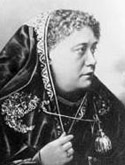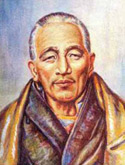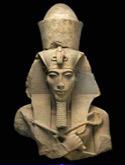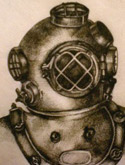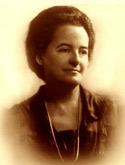Abraham Maslow Father of Humanistic Psychology, the Psychology of “Self-Actualization”.
(April 1, 1908, New York City, time unknown. Died, June 8, 1970, Menlo Park, California, of a heart attack. A proposed rectification has been offered based upon a speculative time of 10:31:51 AM.) Whether or not this rectification is strictly accurate, much can be derived simply from the planetary positions independently of the Ascendant and the house cusps.


(Proposed Ascendant Cancer. Neptune and Vesta are rising in Cancer; proposed MC in Pisces, with Mercury in Pisces at the MC; Sun and Moon in Aries; Saturn also in Aries; Venus and Mars in Taurus; Jupiter in Leo; Uranus in Capricorn conjunct; Pluto in Gemini; Chiron in Aquarius.)
Abraham Maslow was the “Father of Humanistic Psychology”. He introduced, first, the concept of the Third Force in psychology – Humanistic and Existential Psychology, and then, towards the end of his life, the concept of the Fourth Force in psychology – “Transpersonal Psychology”. Many of us involved with the Ageless Wisdom and the New Age Movement, owe a great debt of gratitude of Maslow’s creative thinking and to the unrelenting positivity which developed in his consciousness once he realized that possibilities connected with the “farther reaches of human nature”, the title of a collection of his writings published posthumously.
His early work in psychology was conventional enough; he was in a way a laboratory psychologist studying primate behavior (a good opportunity to use the fifth ray!). Later, after leaving the University of Wisconsin where he did all his undergraduate and graduate work, he became a member of the psychology faculty of Brooklyn College (where he served from 1937-1951). During this time he developed one of his key concepts – the “Hierarchy of Needs”.
Briefly, Maslow noticed (largely as a result of his studies with baby rhesus monkeys), that some needs were more pressing than others. Certain relatively basic needs are quickly forgotten if even more fundamental needs are unfulfilled. He transferred the concept to human behavior and elaborated it into a five-leveled construct. The following diagram illustrates these needs:
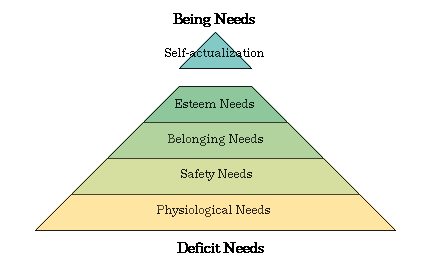 Maslow sought to understand human neurosis in terms of the non-fulfillment of needs. If, in childhood, a certain level of need was poorly met, the consciousness may “fixate” upon it and obsess over meeting such needs long after the needs have actually been met! For instance, those who have spent their childhood in a war situation without sufficient food and safety, may continue to worry about sufficiency of food and their personal safety long after they have enough food and are actually safe. He sought to help people understand and meet their lower-level needs so that they would be freer to pursue the fulfillment of progressively higher order needs. Those who have fulfilled the four lower categories of needs and are at work on the triangle which caps the pyramid are involved in the process of “self-actualization” (a process innately self-satisfying and virtually endless).
Maslow sought to understand human neurosis in terms of the non-fulfillment of needs. If, in childhood, a certain level of need was poorly met, the consciousness may “fixate” upon it and obsess over meeting such needs long after the needs have actually been met! For instance, those who have spent their childhood in a war situation without sufficient food and safety, may continue to worry about sufficiency of food and their personal safety long after they have enough food and are actually safe. He sought to help people understand and meet their lower-level needs so that they would be freer to pursue the fulfillment of progressively higher order needs. Those who have fulfilled the four lower categories of needs and are at work on the triangle which caps the pyramid are involved in the process of “self-actualization” (a process innately self-satisfying and virtually endless).
During the 1930’s Maslow met many illustrious people who were fleeing the Nazi regime. Some of these people were the “crème of European Jewry”. Maslow found in them special qualities which were not abnormal but “super-normal”. He admired such people and began studying them, noting the qualities which distinguished them from more ordinary individuals.
He noticed the following qualities in self-actualizing people:
a. they were reality centered
b. they were problem-centered
c. they had a different perception of means and ends
d. they had a need for privacy
e. they were relatively independent of culture and environment
f. they resisted enculturation
g. they had democratic values
h. they had compassion
i. they enjoyed intimate personal relationships
j. they had an unhostile sense of humor
k. they accepted themselves and others
l. they had spontaneity and simplicity
m. they had a certain freshness and appreciation of life
n. they were creative
o. they had more peak experiences than other people. (A peak experience is an experience of exaltation, union, great joy, happiness, profound compassion, etc. As esotericists we would say it is the result of a very full soul-infusion with even a touch of the spirit/monad.)
Maslow found that self-actualizing people also had certain needs upon which their happiness depended. In order to be happy they needed the following:
a. Truth, rather than dishonesty.
b. Goodness, rather than evil.
c. Beauty, not ugliness or vulgarity.
d. Unity, wholeness, and transcendence of opposites, not arbitrariness or forced choices.
e. Aliveness, not deadness or the mechanization of life.
f. Uniqueness, not bland uniformity.
g. Perfection and necessity, not sloppiness, inconsistency, or accident.
h. Completion, rather than incompleteness.
i. Justice and order, not injustice and lawlessness.
j. Simplicity, not unnecessary complexity.
k. Richness, not environmental impoverishment.
l. Effortlessness, not strain.
m. Playfulness, not grim, humorless, drudgery.
n. Self-sufficiency, not dependency.
o. Meaningfulness, rather than senselessness.
It was Maslow’s estimate that perhaps only two percent of the world’s population was truly self-actualizing. With these thoughts in mind, we can undertake an astrological study of Abraham Maslow. First, there are justifications for using the chart here proposed, as certainly other charts are possible.
A strictly qualitative study of the chart (though useful) is often dangerous as astrologers can “read into the chart” qualities which they know to exist in the individual. A study of cycles is, therefore, indispensable. It is in relation to transits, progressions, directions and eclipses that a chart can be reasonably confirmed, and then the qualitative approach may be more confidently pursued. This is not to say that a qualitative analysis may not be useful and an indication of the correctness of a rectification even before there is relative certainty; only that the dynamic or cyclic factors in the chart should make sense, otherwise the chart may well be fallacious.
If we succeed to bring the angles of a chart to within a degree or two of correctness, we shall have succeeded in our rectification.
Perhaps the first thing we do is look at the picture of the client. In this case you can study the three pictures above. The face should reveal the signs. In Maslow’s case we notice a slightly diamond shaped face which is commonly found with strong Cancer and Capricorn. Both signs are represented in his chart even without the proposed Cancer Ascendant. We note the lips are large and the mouth wide; these are indications commonly (but not exclusively) found when Cancer is strong in the chart. We note the eyebrows are faint – a Cancerian indication. The nose is outstanding. It is very broad as in the case of those who have strong Taurus and sometimes strong Leo (the flattening of the Lion’s nose – not in all decanates). Mars is the ruling planet of his Aries Sun, and Mars is placed in Taurus, thus accounting, partially, for this feature.
The Sun is also in the Lion decanate of Aries (the second decanate ruled by Leo), and thus the broadening influence is strengthened. Venus is there too. Venus rules Taurus and thus disposits Mars. This strengthens the obvious Taurean features of the face, including the lowering of the forehead – a Taurus/Scorpio trait in many instances. But there is such an unusual emphasis upon the nose that one begins to suspect another influence – that of Cancer, which frequently enlarges the nose, especially the area around the nostrils. Maslow’s nose is unusual for its size and Cancer can often give the so-called bulbous nose. We notice also a cleft at the tip of the nose.
This is Cancerian or Capricornian in nature. Either of those two signs will give this distinguishing feature, as will the influence of Capricorn or Cancer as zodiacal decanate rulers. Not only do planets rule decanates (ten degree sections of third degree signs), but whole signs rule decanates as well. In this case, Maslow has his exoterically ruling planet Mars (ruler of the Aries Sun-sign) in the Capricorn decanate of Taurus, and Venus is also there.
This may be enough to give the cleft in the nose, but Cancer could also be involved – especially because of the size of the nose. We also notice that the chin is not strong. Whereas Capricorn does give a strong chin, Cancer weakens the chin generally. The chin associated with Aries is neither large nor small. So again, given all other factors, we suspect the Ascendant as Cancer.
A physiognomic analysis like the one above is a good place to start. Obviously it is only a beginning. A chart can be erected on the basis of appearance and then checked for conformity with the general life pattern. The Cancer-rising chart seems neither necessary nor unnecessary in the life of an eminent psychologist, so by itself, it will not provide sufficient indication. There is, however, a great emphasis on professionalism (with the Sun/Moon conjunction in the tenth house and Saturn there as well. Also Mercury is on the MC, a good placement for an author and theorist. Interestingly, Neptune and Vesta rise. This must be significant if the chart is accurate and we shall see as we proceed why they may be so.
In the method of rectification chosen for Maslow, eclipses (especially solar eclipses) played a very important role.
We not that, for instance, in 1951, Maslow became head of the psychology department at Brandeis University, after some fourteen years of teaching at Brooklyn College. This would represent a significant elevation in status and authority. We first look for the eclipses which occurred around this period, granting them a possible year of influence after the event and with a noticeable effect occurring even six months before the eclipse. We find the following.
Sun SEcl (X) Tr-Tr Sep 12 1950 12:38 18°Vi49′ D Sun SEcl (X) Tr-Tr Mar 8 1951 05:53 16°Pi29′ D
There is a solar eclipse in on the IC (home) on September 12, 1950 and an even more significant solar eclipse on the MC on Mar 8, 1951.
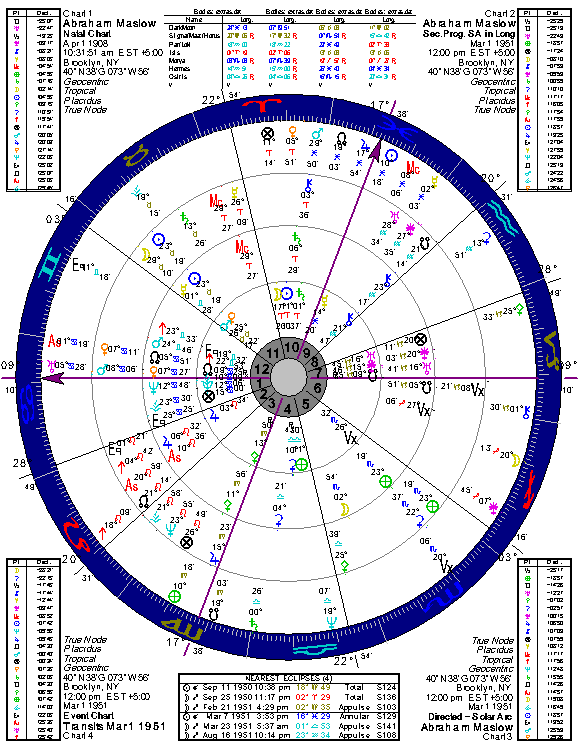
If we examine the chart above for the period, we shall notice that transiting Jupiter is at the MC and moving towards a conjunction with the Sun/Moon conjunction. Presumably by this time in March, he was notified of his new appointment at Brandeis. The eclipse on the MC puts a tremendous emphasis there and the transit of Jupiter only adds to the elevation.
As well, and it is startling, we see transiting Uranus crossing the Ascendant bringing a great change in life which would promote soul purpose. One could set the chart on the indications above and be relatively confident. But let us go further.
We will not consider the time of Maslow’s death, June 8th, 1970. It is just about one “draconic cycle” later. The Moons nodes have completed a cycle and therefore eclipses will be approximately the same as they were nineteen years earlier in 1951. We find the following:
Sun SEcl (X) Tr-Tr Sep 12 1969 04:58 18°Vi54′ D Sun SEcl (X) Tr-Tr Mar 8 1970 02:37 16°Pi44′ D
Note that, indeed, the eclipses are very similar to the 1951 eclipses. They occur on the IC (the “end of life”, as it is called, about nine months before the death, and on the MC in Pisces about three months before Maslow’s final heart attack). Solar eclipses on important points in the chart will often be found before or shortly after important events. Towards the later part of life, solar eclipses on the angles or the “lights” (Sun/Moon) can signal death. It often works this way.
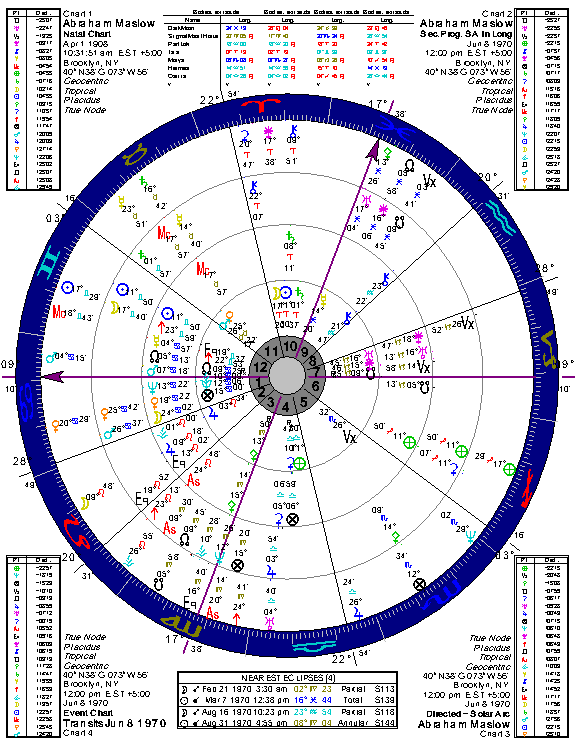
In addition to these two potent eclipses, we find transiting Saturn as 16° plus Taurus on the progressing MC at 17° plus Taurus. The Moon had entered Leo, the sign of the heart, and Maslow had been ailing for some time. Transiting Uranus is conjuncting SA directed Jupiter, the planet ruling the heart. But most importantly, and confirming the chart almost beyond any shadow of a doubt, we see SA directed Uranus exactly conjunct the proposed MC, bringing the career to a sudden end through death. Uranus is directly associated with the heart and is a planet implicated in heart attacks. Planets directed by solar arc do not retrograde.
They simply move as the Sun moves, about one degree per year. The author’s astrology teacher, Charles Jayne, said of Uranus that it was an excellent timer and could be depended upon to be exact. One would be tempted to move the time of birth by almost exactly two minutes to make SAD Uranus coincide with the MC. This would have to be tested, but then the Sabian Symbol for the degree of the Ascendant would we less appropriate. As it stands “A Large Uncut Diamond” is the symbol for the 10th degree where as for the 9th degree the symbol is “A Tiny Nude Miss Bends Over a Pond Trying to Catch a Fish”. Clearly the 10th degree is most appropriate for one so interested in the refinement of character called “self-actualization”.
We could stop here thinking that we had done enough, and probably we have done sufficient work to be quite confident in the chart we have. But the author tried one or two other things and was rewarded with direct confirmations. The solar eclipses were active again.
Maslow’s first major book was published in 1954, Motivation and Personality. His next very important book was published in 1962, Towards a Psychology of Being. Checking the solar eclipses for these two years we find the following.
Sun SEcl (X) Tr-Tr Aug 10 1953 00:55 16°Le45′ D Sun SEcl (X) Tr-Tr Jan 5 1954 11:31 14°Cp13′ D Sun SEcl (X) Tr-Tr Jun 30 1954 21:32 08°Cn10′ D
The first eclipse in August of 1953 is within four degrees of his progressing Ascendant (the progressing soul-indicator). This is interesting and indicative but not conclusive. The next eclipse occurs within one degree of his natural Uranus. This is important, but not conclusive, because that eclipse would have occurred on Uranus no matter what the Ascendant had been. The last eclipse in 1954, however, occurred within less than a degree of his proposed Cancer Ascendant and even closer to it if we move the time of birth back two minutes to accommodate the “death transit” of Uranus. Note the chart below.
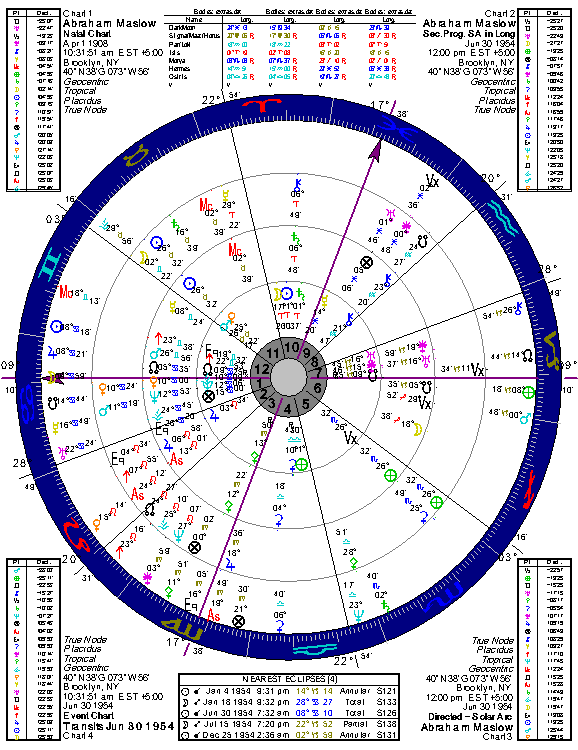
The next eclipses, along the same line, occur in 1961 and 1962 as follows. They coincided with the publication of Toward a Psychology of Being.
Sun SEcl (X) Tr-Tr Aug 11 1961 19:46 18°Le31′ D Sun SEcl (X) Tr-Tr Feb 5 1962 09:11 15°Aq43′ D Sun SEcl (X) Tr-Tr Jul 31 1962 21:24 07°Le49′ D
In the August 1961 eclipse, we find it conjuncting the progressed Ascendant at 18° plus of Leo, and the progressing Ascendant is very time-sensitive. The next eclipse in February of 1962 is conjunct the progressing Descendant within three degrees. This conjunction is as good as a conjunction with the Ascendant, because the progressing Descendant is dependent upon the degree of progressing Ascendant. The third eclipse is important as it conjuncts progressing Jupiter, but progressing Jupiter is not time-sensitive. Nevertheless, we again have the necessary confirmation and can proceed with confidence with the interpretation of Maslow’s chart.
A Summary of Essential Points to Bear in Mind when
a. The soul ray of Abraham Maslow is undoubtedly the second ray of Love-Wisdom. This ray advances through the “attainment of positivity” (R&I 507) and Maslow’s psychology was precisely that – the “psychology of positivity”, the study, not of abnormal and pathological cases, but of the very best human beings to find out what made them the best. Even in his list of qualities that characterized the self-actualizing person, one can see a slight bias towards second ray virtues (but, after all, we do live upon an essentially second ray planet in a second ray solar system!).
b. The astrological conduits for the second ray are as follows. Two of the three signs which transmit the second are tenanted. Pluto is placed in Gemini (this in itself is not much of a second ray indicator) and Mercury, the esoteric ruler of the Aries Sun-sign is placed in second ray Pisces. This elevated Mercury is a very important placement.
c. The Sun and Moon are conjuncted in Aries in which sign the second ray Sun is exalted. This could be an important and radiant transmitter in the chart of a soul focussed upon the second ray.
d. Most importantly perhaps, Jupiter the primary second ray planet, what we might call the “planet of the soul” because it is a sacred planet transmitting the soul ray is in Leo in the second house, esoterically the “house of wisdom”, and is found in Leo, the sign of the heart. In an advanced soul such as Maslow, this is a very positive second ray indicator and accounts significantly for his search for positivity through the Psychology of Self-Actualization.
e. We cannot ignore the rising Neptune, esoteric ruler of the proposed Cancer Ascendant. It has a deep resonance with the second ray, even though in this instance it may be more connected with the undoubted idealism, reverence and veneration for “wonderful people” which stimulated Maslow’s search.
f. We find Venus and Neptune within a degree in the parallels of declination. This is like a conjunction and sensitizes the love nature.
g. As long as we are mentioning Neptune, we may well find that this rising planet of aspiration and transcendence, indicates a sixth ray personality, determined to “rise above” the sickening perspective on human nature presented by abnormal psychology. If one looks closely at Maslow’s eyes (in the photographs provided) one can see both kindness and aspiration – veneration for those of noble character. Neptune confers the power to tune in on the really good things about the human being. This is the planet of “rose-colored glasses”, found in those who are naïve. It cannot be said that Maslow was naïve, however. He was, in his early years, a hard-headed scientist, focussed significantly, so it would seem, on the fifth ray. He also had enough Pluto expressing in his life (Pluto in the twelfth house of the subconscious mind) to understand the dangers of the Neptunian attitude – avoidance of the unpleasant. In fact later, after cataloguing the virtues of self-actualizers, he also catalogued their unexpected liabilities. So it was a realist. No, this Neptune was tuning in on something very real, present in the higher reaches of human nature. The place where bliss can be found.
h. Maslow gave us the term “peak experience” to express the inexpressible happiness, joy and bliss of those who have transcended their lower nature (as we esotericists would say). Neptune is the plane of bliss and transcendence, and Vesta (another partially sixth ray indicator) conjuncting it only intensifies the search for transcendent states. The sixth ray wishes to rise into ideal states. In Maslow’s case, through hard study and much research, he paved the way for what we might call a “legitimate rise”.
i. Other sixth ray indicators are devoted Vesta very highly elevated by declination, and a very close and enthusiastic Mars/Jupiter parallel of declination.
j. The fifth ray seems prominent in his makeup – at least given the early research performed, and, in general, his interest in research, per se. The only fifth ray sign/constellation transmitting the fifth ray and holding one of the normal planets is Leo in which Jupiter is placed. This is hardly a fifth ray indication. However, Venus the planet of the fifth ray is in its own exoteric sign, Taurus, and is conjunct the partially fifth ray ruler exoteric ruler of Aries, Mars. Mars rules exoteric science and the five senses we are told. They are both placed in a very material though knowledge-oriented sign, Taurus. Interestingly, there is an aspect of 72° between the usual mental indicator, Mercury, in Pisces, and the Venus/Mars conjunction.
This aspect, the “quintile” is formed by dividing the 360° circle by five. Thus, the aspect itself, containing three planets intimately associated with the mind – Venus, higher mind; Mars, lower mind; and Mercury all phases of mind (though more intuitive here) – is a strong indictor of the possible presence of the fifth ray. This aspect probably made possible Maslow’s work with primate research and his later researches into sexuality (as Taurus is one of the sexual signs, and sexual Mars is placed therein).
k. Not having known Abraham Maslow personally, it is not easy to determine his possible astral ray. Aspects of both ray six and ray two are suggested. One can feel him moving ever closer to a second ray manifestation in the astral body as his life proceeded.
l. The ray of the physical body cannot also be easily determined. In his photographs he does not appear fastidious, yet there are many indicators which involve seventh ray signs – Saturn in Aries, Cancer rising and holding Neptune and Vesta and seventh ray Uranus in the sign which most strongly expresses the seventh ray at this time – Capricorn.
m. The ray chart, then, would look something like this: 26-5 6/2 7?
n. The Sun/Moon conjunction (a new Moon conjunction, really) made of Maslow a pioneer – though hardly an offensive pioneer who ran over others as more first ray individuals might tend to do. Instead he eagerly advanced new and progressive ideas, founding two major psychological movements: Third and Fourth Force Psychology (i.e., Humanistic Psychology and Transpersonal Psychology). Can we say that the study of esoteric psychology based upon the seven rays, esoteric astrology and the chakra system, will constitute a Fifth Force in psychology? There is good reason to believe so.
o. We can see in him the great enthusiast, driven in relation to his work. The Sun and Moon conjuncted in a sign which knows little restraint and in a house which relates to professionalism, tells of his dedication to his work.
p. It is perhaps fortunate that serious, restraining Saturn is so elevated in the chart, checking impulsiveness with purposefulness, and “applying the brakes” when necessary. It would also confer ambition and point to the way in which Maslow sought to satisfy his parents by pursuing education so seriously and orienting himself at first towards lines of education which they promoted. When he discovered psychology, an indifferent student changed into an ardent student, as might be expected with so much Aries and a personality proposedly on the sixth ray.
q. We do see an opposition to the Sun/Moon conjunction from caring, nurturing Ceres in Libra the sign of peace and right human relations. Maslow, it would seem, was not an offensive Aries, having so much second ray, and in general, so much of the soft line in his makeup. This Ceres position could only add the agreeableness of his nature and his hope for nurturing, cooperative relationships. It is placed in the fourth house which is a strong placement for a planet of its nature.
r. The concept of the Hierarchy of Needs seems related to his two earth signs and the planets they contain. Taurus is ever aware of that which is missing and must be acquired. The orthodox ruler of the Sun, Mars is placed there, conjunct the natural ruler of Taurus, Venus. Maslow knew intimately, what man desired and the relative importance of those desires. Perhaps Uranus in Capricorn, really a very seventh ray combination, gave him the notion of Hierarchy. It was a very original concept (for twentieth century psychology) and yet very ancient. It allowed him to conceive of this hierarchy as a transformational ascent towards the fulfillment of ever higher needs. He took it upon himself to teach people how to ascend that hierarchy by fulfilling lesser needs so that they could be liberated (Uranus) to fulfill greater.
s. Uranus is closely square to the Sun/Moon conjunction showing Maslow to be a true agent of transformation. Aries people do not easily accept the status quo sometimes associated with Libra. They demand the new and change; we can see how Maslow’s Uranus position, focused in the house of relationships, would further this demand for the new.
t. Interestingly, Maslow did an unconventional thing, against the wishes of his parents. He married his cousin (Uranus conjunct Juno – part ruler of the fourth house of family). They had two children and an apparently happy married life. As another confirmation of the Cancer Ascendant, those influenced by that sign are liable to seek for a partner someone who seems “familiar”, for instance a member of the family. Cancerian men often marry those who remind them of their mother.
u. The elevated Mercury position in the sign of its fall but conjunct the proposed MC is very powerful. Mercury, already in an intuitive sign, Pisces, is trined by one of the rulers of Pisces – Neptune, the planet of intuition. Whatever may have been his concrete mental abilities (and the Mars/Venus conjunction in Taurus shows them a sufficient to academic psychology), his intuitive sense of the sublime must have been very refined. This aspect, Mercury/Neptune, involving the two signs in which Neptune rules (Cancer and Pisces), puts him directly en rapport with the buddhic plane, the plane of harmony and of unitive love. It would seem that he received great inspirations from that higher world and saw that some human beings had achieved a real access to that world. He wondered why more people could not touch it, and thus be happier, more fulfilled, more “self-actualized”.
v. The healing potentials of Mercury, the “caducean god” should not be ignored, as Mercury is placed in a healing sign, Pisces, and very closely parallel the planet of healing, Chiron. Maslow must have been possessed of what Master D.K. calls a very high psychic power – the ability to sense a brother’s need.
w. The Jupiter position in Leo is also extremely important, as Jupiter is a “soul ray planet”. The second house is the “treasure chest” of the astrological chart. It speaks of gifts, talents and resources – in this case, spiritual resources. The accumulated contents of the causal body are found indicated in this house. Leo is the sign related to the expression of the causal body, and Jupiter indicates the fulness of the causal body and the full expression of that repository of garnered quality.
x. So much of Maslow’s psychological philosophy can be seen in this Jupiter position. We all have gifts. Some can express these gifts. The more fully these gifts can be expressed, the more integrated and self-actualized, self-fulfilled the individual becomes. He was interested in seeing more people come to fulfillment through the full expression of their higher (and often hidden) abilities. We can see this position as a position of abundance. The abundance relates to quality. Maslow studied the spiritual qualities in the “treasuries” of highly developed people. He studied the reason for their happiness, their joy, their occasional bliss. He sought to show less fulfilled people how they might become more fulfilled – just like the exemplary people he studied.
y. He, himself, was in the process of becoming fulfilled. He must have realized his own deficiencies yet sensed that there was something “very good” within his own nature and in that of many people. Like a true second ray individual, he tried to draw that forth, creating, in fact, a psychology of joy rather than of pathology and despair.
z. The fixed stars tell an unusual story with Venus conjunct the deadly star Algol and both nodes and the Ascendant parallel the forceful, even brutal, star Hamal. Perhaps these parallels conferred great independence of thought and the ability to go forward with one’s theories despite the disbelief and scorn of one’s colleagues. The Venus/Algol conjunction may have been involved in the study of sexuality which interested him, just as the Mars/Venus conjunction in sexual Taurus surely would be.
aa. A very beautiful conjunction between Neptune and Sirius is prominent. Many people both near the date of Maslow’s birth would have had this indication, but let us remember that Neptune is Maslow’s rising planet and is also the esoteric ruler of his Ascendant – the point in the chart that is supposed to be oriented toward soul fulfillment.
bb. Those who tread the Path to Sirius are known as “blissful dancing points of fanatical devotion”. They are possessed by “cosmic rapture” and “rhythmic bliss”. Could we not say that the “peak experiences” that Maslow saw as points of great inspiration, were reflections of these blissful Sirian qualities?
cc. We can be sure that Abraham Maslow “saw” some of the higher possibilities of human nature. He admired them, and the people who demonstrated them. We can see, in fact, that he sought to emulate them and to encourage more human beings to become as the best of human beings.
dd. Maslow’s is a psychology of elevation – elevation to the “mountain top”. We can say that Abraham Maslow saw the mountain. Perhaps, like Martin Luther King (though on a different ray) he, too, had “been to the mountain”. Surely, as time progressed, the peak experienced induced by great love were not unfamiliar to him.
ee. The title of one of his most famous books is of real interest here: “Toward a Psychology of Being”. True being is only met on the “mountain top” where peak experiences occur. True being is the prerogative of the monad and it is Aries that leads one into contact with that monad as an aspect of pure being. The Tibetan says the following: “1. The secret of Aries is the secret of beginnings, of cycles and of emerging opportunity. At the third initiation, the initiate begins to understand the life of the spirit or the highest aspect; until that time, he has expressed first the life of the form and then the life of the soul within that form. This experience is of so high a nature that only those who have passed through it could in any way comprehend anything I might say”. (EA 387-388) We can see that Maslow aspired towards being, which he knew he could meet upon the “mountain top”. This is definitely aspiration towards the third initiation.
ff. It is not possible to tell whether he experienced the “mountain top” in any more permanent way, and thus became a true third degree initiate, but we can see that his mind and consciousness were oriented in this direction.
gg. As well, he had the necessary astrological qualifications. Aries was powerfully present. Saturn, the esoteric ruler of the sign of initiation, was placed in Aries. Uranus (representing the Hierophant met as a “star” at the time of the third degree) is placed in Capricorn, the sign of initiation. And Cancer, the sign which represents the willingness to take the mountain-top revelation deep into the substance of humanity (and thus redeem) is also present as the Ascendant, directing toward soul fulfillment.
hh. Certainly, Maslow had developed the emotional positivity required of the second degree. He valued all that was good and high about emotional expression. Buddhi had made its way into his astral body.
ii. Maybe the “mountain top” remained a distant and flickering reality. Maybe he experienced it now and then and continued to aspire towards it. Or maybe, he achieved some stabilization at that high point of tension required of those who are capable of revealing unity.
jj. In a way, he certainly did reveal the possibility of experienceable unity. He knew what peak experiences were; he justified them, placed them within an academically respectable context and popularized their nature and existence. He, thereby, brought people closer to the heights of their own human nature.
kk. This is, after all the task of the Capricorn/Cancer individual who had see the “light supernal” and can say, from the mountain top, “The Whole is seen as One”.
ll. We see that initiates of the threshold and true initiates are active in all disciplines and present their revelations along all rays. Abraham Maslow’s revelation was a second ray revelation. He was one of the leading proponents of what became the “Human Potential Movement” and what is this movement but a way of releasing the inner content of the soul – the “Christ Principle” within man.
mm. Certainly his work can be understood as directly related to the Divine Plan – especially as its focus was in a country, the United States, which has a second ray soul and whose responsibility it is to express the mantram, “I Light the Way”.
nn. Maslow and others of his kind opened the way more wisely into the vision and experience of the soul. For that we owe him a debt of gratitude – probably one of the foremost qualities of a truly self-actualizing individual.

